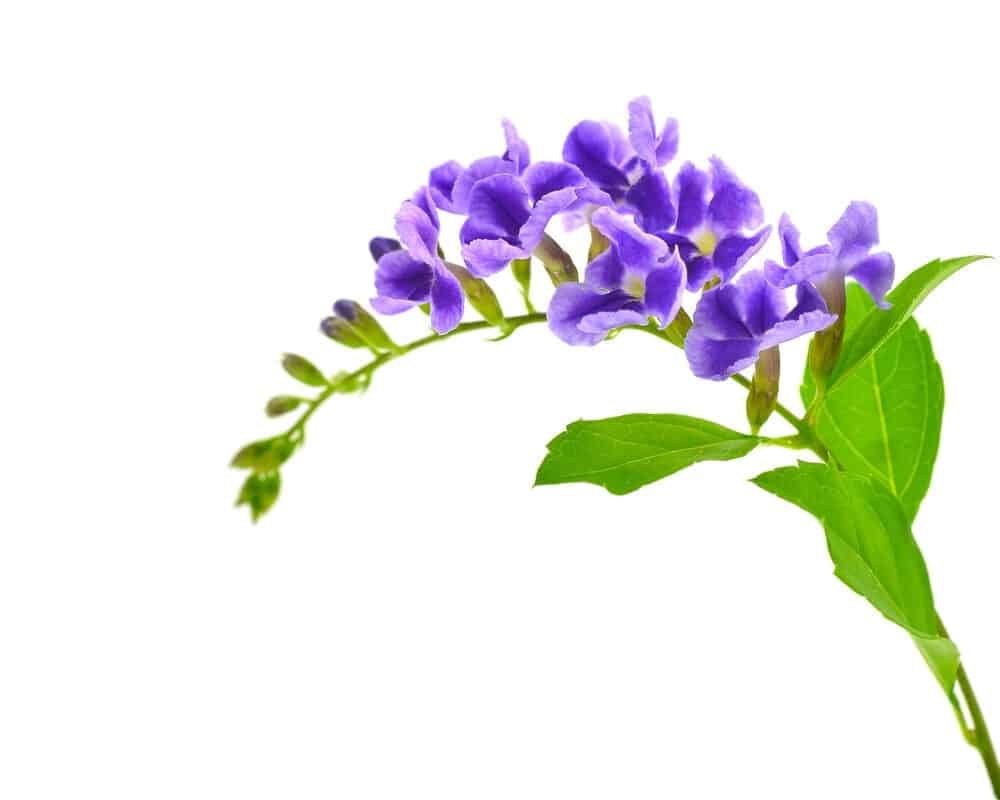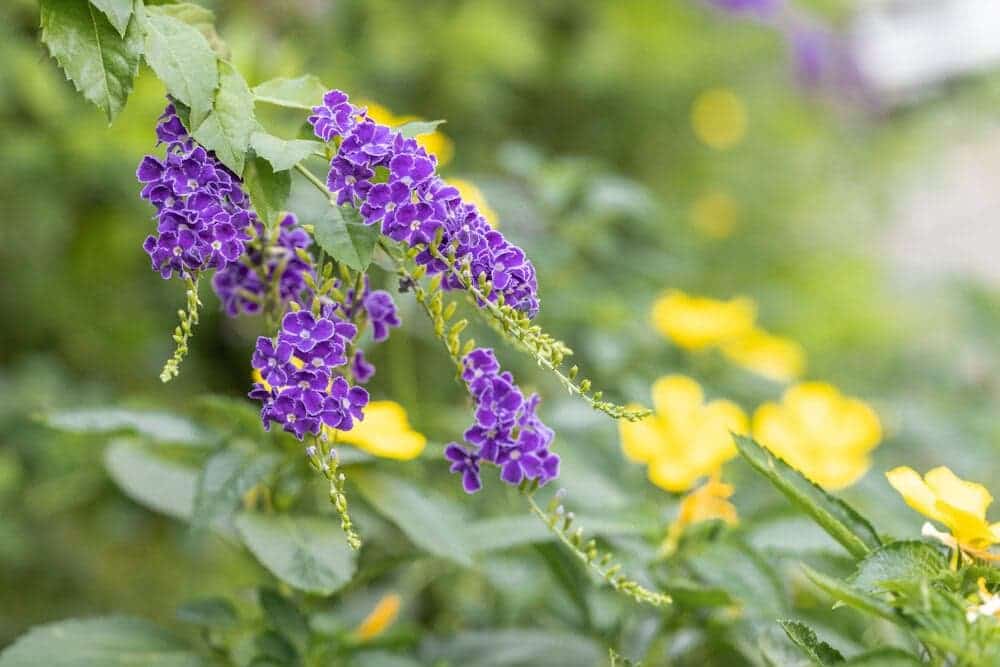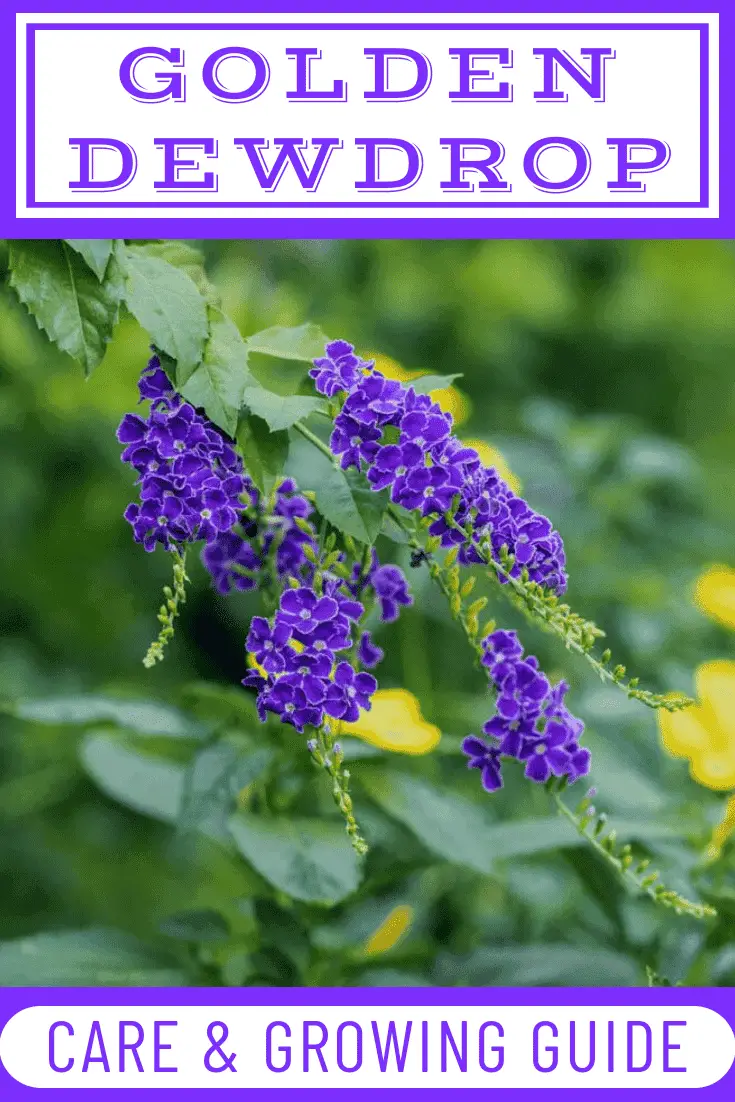The Golden Dewdrop plant is uniquely beautiful when in full bloom.
This plant is very popular all across the country because of its colorful flowers. It is also incredibly easy to grow and maintain.
If you want to grow a plant that is gorgeous but low-maintenance, this is a great overall option.
Golden Dewdrop Care & Growing Guide
1. Light Requirement
Full sunlight is an absolutely must for golden dewdrop plants. You can grow one of these plants in partial shade, but not full shade. This plant needs lots of natural sunlight to grow and stay healthy both in the short and long term.
Those who attempt to grow one of these plants in too much shade will quickly find that the leaves will begin to droop. It is also very difficult to get this plant to produce flowers without lots of bright direct sunlight.
2. Water
These plants need a good amount of water, but too much can quickly kill them. If you are growing one of these plants outside, you will need to give your plant what amounts to about an inch of rain.
If you are growing your golden dewdrop inside, you should only water it when the top layer of soil feels dry to the touch. Just run your finger along the surface of the soil to determine whether your plant needs a drink.
3. Climate
The Golden Dewdrop plant can be grown in climate zones 13 through 24. This is a fairly versatile plant that is capable of being grown just above anywhere. It tends to thrive in semi-tropical climates.
4. Soil
You should put your golden dewdrop plant in organic soil for the best possible growth results. If you are growing it in a pot, it should be large enough to let the roots spread out without getting tangled up.
Loamy, well-draining soil is an absolute necessity for these plants. Make certain that the container you put it in has enough holes for proper drainage. This is a crucial aspect of growing these plants without any issues.

5. Temperature
If you plan on growing your golden dewdrop plant in a container, you’ll want to take inside when it starts getting colder. These plants do not tolerate temperatures of below 40 degrees Celsius, so you’ll need to keep that in mind.
6. Repotting
When you are going about repotting a golden dewdrop plant, you’ll want to take special care not to damage the root system. If the roots are tangled around the rootball, you’ll need to remove them gently so as not to do any damage.
Transfer the plant into a new container that is twice as large as the previous one. This will give the roots all the space they need to expand. The last thing you want is for the root system to become compromised shortly after repotting.
7. Speed of Growth
These plants grow pretty quickly when kept in direct bright sunlight. They will grow significantly slower when kept in shade.
8. Height and Spread
The Golden Dewdrop plant can grow up to 20 feet tall once it is a fully matured adult, with a maximum width of 20 feet.
9. Flowers
The purple flowers that this plant produces are very beautiful and vibrant to say the least. These plants bloom throughout the year at different times. Some golden dewdrops produce yellow drupes that can add some nice color variety to your garden.
10. Trimming
You can begin trimming your golden dewdrop plant whenever it begins growing out too far. Keep in mind that this plant grows as a hedge plant in tropical regions.

Is the Golden Dewdrop Plant Poisonous?
It is important to keep in mind that Golden Dewdrop plants are poisonous to humans, dogs, cats and all other animals. In fact, every single part of this plant is considered to be poisonous. It is possible for pets or small children to die from ingesting it.
How to get Golden Dewdrop Plant to Flower
One of the most important things when it comes to getting a Golden Dewdrop plant to flower is providing it with adequate light. As we mentioned above, it is crucial that these plants get full sunlight throughout each day. It is very difficult to get these plants to bloom if you keep them in partial shade.
Common Golden Dewdrop Plant Diseases
Leaf spot disease is a pretty common problem with Golden Dewdrop plants. This disease usually presents as brown spots on the plant’s leaves. This disease is often caused by insects as well as bacteria. These spots can be small or very large, depending on the cause.
It is very important for you to remove any foliage on the plant that has dark spots on them. This will help to prevent the spread of the disease so your plant does not die.
If you are having problems with pests on your plant, you’ll want to make a point of spraying them off with water. There are numerous repellent spray products on the market that are designed to keep these pests away. Take the time to find a product that will work effectively to protect your plant.
Conclusion
- Golden Dewdrop plants require full bright sunlight to grow normally and stay healthy.
- If you are growing this plant outside, it should get the equivalent of one inch of rain every single week.
- If you are growing it inside, you’ll need to wait until the first inch of the soil get dry before watering it.
- These plants can be grown in USDA hardiness zones 13 through 24.
- Make sure that you grow your golden dewdrop plant in loamy soil that drains well.
- You’ll need to be very careful with the roots of this plant when repotting. Make sure that the root system or rootball do not become damaged.
- The purple flowers this plant produces are very beautiful, but it is only likely to bloom when grown outside.
- Make sure that you trim off any leaves with brown spots on them, as this is a sign of disease.

Victoria is the owner and main author of hobby plants. She loves spending her free time in her garden planting and taking care of her plants. Victoria hopes you enjoy the content here!
![Queen Of The Night Flower [Complete Plant Care Guide] Queen Of The Night Flower [Complete Plant Care Guide]](https://www.hobbyplants.com/wp-content/uploads/2022/07/queen-of-the-night-flower-300x158.jpg)
![Mother Of Thousands Plant [Complete Plant Care Guide] Mother Of Thousands Plant [Complete Plant Care Guide]](https://www.hobbyplants.com/wp-content/uploads/2022/07/mother-of-thousands-plant-300x158.jpg)
![How Often Should You Water Pothos? [Complete Care Guide] How Often Should You Water Pothos? [Complete Care Guide]](https://www.hobbyplants.com/wp-content/uploads/2022/07/how-often-to-water-pothos-300x158.jpg)
![Can Snake Plants Live Outside? [COMPLETE CARE GUIDE] Can Snake Plants Live Outside? [COMPLETE CARE GUIDE]](https://www.hobbyplants.com/wp-content/uploads/2022/08/can-snake-plants-live-outside-300x158.jpg)
![Majesty Palm Plant Care: [Complete Beginner's Guide] Majesty Palm Plant Care: [Complete Beginner's Guide]](https://www.hobbyplants.com/wp-content/uploads/2022/08/majesty-palm-care-300x158.jpg)
![Exotic Angel Plant Care: [Complete Beginner's Guide] Exotic Angel Plant Care: [Complete Beginner's Guide]](https://www.hobbyplants.com/wp-content/uploads/2022/08/exotic-angel-plant-care-300x158.jpg)
![Do Coleus Like Sun Or Shade: [Complete Care Guide] Do Coleus Like Sun Or Shade: [Complete Care Guide]](https://www.hobbyplants.com/wp-content/uploads/2022/08/coleus-sun-or-shade-300x158.jpg)
![Snow White Waffle Plant: [Complete Care Guide] Snow White Waffle Plant: [Complete Care Guide]](https://www.hobbyplants.com/wp-content/uploads/2022/08/snow-white-waffle-plant-300x158.jpg)
![Waffle Plant Care: [Complete Beginner's Guide] Waffle Plant Care: [Complete Beginner's Guide]](https://www.hobbyplants.com/wp-content/uploads/2022/08/waffle-plant-300x158.jpg)
![Bird Of Paradise Plant Care: [Complete Beginner's Guide] Bird Of Paradise Plant Care: [Complete Beginner's Guide]](https://www.hobbyplants.com/wp-content/uploads/2022/08/bird-of-paradise-plant-300x158.jpg)
![Purple Passion Plant Care: [Complete Beginner's Guide] Purple Passion Plant Care: [Complete Beginner's Guide]](https://www.hobbyplants.com/wp-content/uploads/2022/08/purple-passion-plant-care-300x158.jpg)
![China Doll Plant Care: [Complete Beginner's Guide] China Doll Plant Care: [Complete Beginner's Guide]](https://www.hobbyplants.com/wp-content/uploads/2022/09/china-doll-plant-care-300x158.jpg)